Wholesome baby food carrots
Carrot for Baby Food | Wholesome Baby Food
Learn all about Carrots and try some Carrot baby food recipe ideas.
When can I introduce Carrots to my baby?
Carrots may be introduced between 6 and 8 months of age. As always, I recommend that you thoroughly discuss any feeding issues with your pediatrician as generalities may not apply to your child.
Goodness of Carrots
Carrots are very high in beta carotene. Beta carotene is a Carotenoid. Carotenoid are a set of darkly colored pigments called pro vitamin A carotenoids that can be converted to Vitamin A. Vitamin A is very important in a developing infant’s diet.
Carrots are often one of baby’s first food. They are easy to digest and are packed full of nutrients such as Vitamin A, Vitamin C and Calcium.
Due to the issue of Nitrates, recommendations for the introduction of carrots varies. I have found that more often than not, the recommendation for introducing carrots is between 7 and 8 months old. Again, please see the Nitrates article for more in-depth information.
CARROTS: (half cup steamed)
| VITAMINS: Vitamin A – 13286 IU Vitamin C – 1.8 mg Niacin – .4 mg Folate – 11 mcg Pantothenic Acid – .2 mg Vitamin B6 – .2 mg | MINERALS: Potassium – 177 mg Sodium – 51.5 mg Calcium – 24 mg Phosphorus – 23.4 mg Magnesium – 10 mg Iron – .48 mg |
How to select and store the perfect carrots for homemade baby food
According to the EWG, carrots are not one of the “dirty dozen” foods that are most highly contaminated with pesticides – purchasing organic is a personal choice.
Select and store carrots
When purchasing carrots, look for those with minimal sprouting at the top. In other words, if the carrot has started to grow, it has been sitting around for quite some time. Also look for little “hairs” growing along the carrot. This also indicates the carrot is growing and has probably been sitting around for awhile.
In other words, if the carrot has started to grow, it has been sitting around for quite some time. Also look for little “hairs” growing along the carrot. This also indicates the carrot is growing and has probably been sitting around for awhile.
The best way to preserve the flavor, crispness, and beta-carotene content in carrots is to refrigerate them.
Is it a good idea to use “baby carrots”?
“Baby” carrots are the product of modern technology and are specially formed by a machine that cuts them out from full sized older carrots. Some “growers” add green food coloring at the “stem” for further effect. One way to tell if a baby carrot is truly a baby carrot is to read its packaging. The common “baby carrots” sold in the grocery store will actually say “baby cut” carrots.
Baby cut carrots are cleansed in a solution that often contains chlorine so that they will not turn white while in the package. Skip these carrots and opt to peel and cut your own, especially if you will be making carrot baby food!
Visit this link at USA Today to read all about the inventor of the “baby carrot”.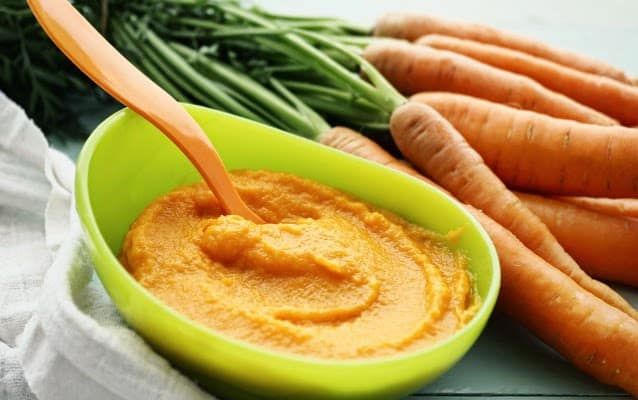
How prepare carrots
When purchasing carrots, look for those with minimal sprouting at the top. In other words, if the carrot has started to grow, it has been sitting around for quite some time. Also look for little “hairs” growing along the carrot. This also indicates the carrot is growing and has probably been sitting around for awhile.
The best way to preserve the flavor, crispness, and beta-carotene content in carrots is to refrigerate them.
When preparing Carrots, steaming is the very best method for cooking and preparing them. Steaming Carrots allows the beta carotene to be more bio-available and readily used by the body. Add a wee bit of butter to help better absorb the vitamin A.
Carrots should be peeled when making baby food purées as many infants will not be able to digest the skins. Unless you are purchasing Organic carrots, you should always peel carrots as chemicals do concentrate in the skin of the carrot. If you do not buy Organic carrots, please cleanse the carrots by using a vegetable brush and lightly scrubbing the carrots under cool running water.
Enjoy A Tasty Carrot Baby Food Recipes
Carrots – Basic Purée
- Any amount of fresh carrots you desire
Directions:
Step 1: Peel carrots and cut into small chunks
Step 2: Place chunks into a steamer pan with just enough water visible through the steamer basket
Step 3: Steam until tender
Step 4: Do not reserve any left over water to use for thinning out the carrots if baby is under 8 months old as Nitrates may seep into the cooking water
Step 5: Place into your choice of appliance for pureeing and begin pureeing.
Step 6: Add water as necessary to achieve a smooth, thin consistency.
Carrots – Baked Carrots for Homemade Baby Food
- Any amount of fresh carrots you desire
Directions:
Step 1: Peel carrots and cut length-wise into thick slivers.
Step 2: Oil a glass casserole dish with Olive Oil and then place the carrots into the glass casserole dish.
You may dash some garlic powder, basil and/or Italian seasonings (dried basil, oregano, rosemary all together), or even yummy tarragon, over the carrots if your baby is 8 months+ and eating spices. Visit our When can baby have spices page to learn more.
Step 3: Bake carrots at 350 F for approximately 45 minutes or until carrots have turned fork tender and have changed to a dark orange.
Step 4: Puree, adding water as needed, and serve or freeze. You can also cut the carrots into little bits and serve as finger food. Or, freeze the carrot dices in a freezer bag. This will allow you to serve up some “fast food” – baked carrots for finger foods.
Carrot-Rice Casserole (8 months+ due to dairy)
- 3 cups grated carrots
- 3 cups cooked brown rice
- 1/2 cup finely chopped onion
- 1 tablespoon minced fresh parsley
- 1/4 teaspoon salt (no real need) – see our Salt in Baby Food article
- 1-1/2 cups evaporated skim milk (try plain yogurt instead.
 )
) - 1/2 cup egg yolks
- 3 tablespoons grated nonfat or reduced-fat Parmesan cheese
Directions:
Step 1: Combine the carrots, rice, onions, herbs, and salt in a bowl, and stir to mix well.
Step 2: Add the milk (or yogurt) and egg yolks, and stir to mix.
Step 3: Coat a 2-quart casserole dish with nonstick cooking spray, and spread the mixture evenly in a dish.
Step 4: Sprinkle cheese over the top.
Step 5: Bake at 350 degrees for 50 minutes to 1 hour, or until a sharp knife inserted in the center of the dish comes out clean.
Step 6: Remove dish from oven and let sit for 5 minutes before serving. Serves approx. 8.
Mashed Turnip & Carrot Delight
Ingredients:
- 1 very large turnip ( or many small ones)
- 6 large carrots ( or as many as you like)
- spice to taste
Directions:
Step 1: To begin peel skin off of the turnip then cut turnip into pieces… size doesn’t matter, but the smaller you cut them the faster they will boil.
Step 2: After cutting the turnip place in a saucepan with water and boil till done (when you can stick a fork through piece, it’s done).
Step 3: Cut up carrots and steam until tender – or steam turnips and carrots together.
Step 4: When turnip & carrot are ready, put both in one bowl or saucepan and mash them together. Or you can mash them separately (food processor can also be used) and then mix them together.
Step 5: Add spices as desired.
Foods Good to Mix With Carrots:
- Apples
- Peaches
- Green Beans
- Dried Beans
- White Potato
- Sweet Potato
- Peas
- Summer Squash – zucchini or yellow/crooked necked
- Winter Squash – butternut, acorn etc.
- Brown Rice
- Lentils
- Chicken
- Beef
- Pork
- Tofu
What does the AAP (American Academy of Pediatrics) say about Homemade Carrots?“Because the intake of naturally occurring nitrates from foods such as green beans, carrots, squash, spinach, and beets can be as high as or higher than that from well water, these foods should be avoided before 3 months of age, although there is no nutritional indication to add complementary foods to the diet of the healthy term infant before 6 months of age” AAP – Nitrate Statement AND “Preventive strategy would be not to introduce home preparations of these vegetables to infants before 3 months of age, although there is no nutritional indication to add complementary foods to the diet of the healthy term infant before 4 to 6 months of age. AND “Because vegetables, including green beans, carrots, squash, spinach and beets, can have nitrate levels as high or higher than that of well water, infants should not eat these foods until after age 3 months.” AAP – WEll Water Nitrates |
Remember, always consult with your pediatrician regarding introducing solid foods to your baby and specifically discuss any foods that may pose allergy risks for your baby.
Is Your baby taking on an Orange hue? Read about why some babies appear to be turning orange
SHARE ON FACEBOOK SHARE ON PINTEREST
Nitrates, Carrots, and Homemade Baby Food
Myths and Facts About Nitrates and Homemade Baby Food
Homemade Baby Food often gets a bad rap due to nitrates. There are many misconceptions about nitrates, learn the facts here!
There are many misconceptions about nitrates, learn the facts here!
Commercial Baby Food is NOT nitrate free!
Commercial baby food companies say that they screen for nitrate levels – screening does not mean that nitrates are removed. Screening is not mandated by law so the baby food companies police themselves. The use of the term “screen” is often misinterpreted to mean “remove”. Nitrates cannot be removed because they occur naturally!
What are the odds that your baby will get Nitrate Poisoning/Blue Baby Syndrome from Homemade Carrots?
It is important to note that the odds of your baby getting “Blue Baby Syndrome” nitrate poisoning from Carrots or other veggies is about 0%. Yes it’s true, the odds of your baby getting nitrate poisoning from homemade baby food are 0% – zero percent.
By the time you introduce solid foods to your baby, his tummy should be developed enough to handle “normal” nitrate exposure.
Here is what the AAP really says about Nitrates and Homemade Baby Food:
The AAP recommends NOT preparing these foods <carrots et al> for a baby who is younger than 3 (three) months old.
- “Because the intake of naturally occurring nitrates from foods such as green beans, carrots, squash, spinach, and beets can be as high as or higher than that from well water, these foods should be avoided before 3 months of age, “
- ” 1. The greatest risk of nitrate poisoning (methemoglobinemia) occurs in infants fed well water contaminated with nitrates. All prenatal and well-infant visits should include questions about the home water supply. If the source is a private well, the water should be tested for nitrate. The nitrate nitrogen concentration of the water should be <10 ppm.
- ” 2. Infants fed commercially prepared infant foods generally are not at risk of nitrate poisoning. However, home-prepared infant foods from vegetables (eg, spinach, beets, green beans, squash, carrots) should be avoided until infants are 3 months or older, although there is no nutritional indication to add complementary foods to the diet of the healthy term infant before 4 to 6 months of age.
 ” American Academy of Pediatrics – Nitrate Statement
” American Academy of Pediatrics – Nitrate Statement - “Because vegetables, including green beans, carrots, squash, spinach and beets, can have nitrate levels as high or higher than that of well water, infants should not eat these foods until after age 3 months.”
AAP Well Water Statement
The Mayo Clinic also states the following regarding home prepared “nitrate veggies”;
“For babies younger than age 4 months, also avoid home-prepared spinach, beets, turnips and collard greens, which may contain high levels of potentially harmful compounds from soil (nitrates). ”
Who is Most at Risk of Nitrate Poisoning?
So who is most at risk for nitrate poisoning? People who have private wells have the highest risk for nitrate exposure. Babies under the age of 6 months old are most at risk and babies under the age of 3 months old even more so.
Babies who are over the age of 6 months old have developed the stomach acids necessary to fight the bacteria that helps nitrate conversion and subsequent nitrate poisoning. Infants who are formula fed and live on farms or in highly agricultural areas may also be at greater risk. Nitrates used in farming, and the excess not taken in by the crop itself, easily run-off and may seep into water tables, contaminating water supplies.
Infants who are formula fed and live on farms or in highly agricultural areas may also be at greater risk. Nitrates used in farming, and the excess not taken in by the crop itself, easily run-off and may seep into water tables, contaminating water supplies.
As mentioned earlier, nitrate poisoning is very rare and when it does occur, it is typically traced back to ground water contamination – specifically from contaminated private wells.2 If you have any doubts or fears, please speak to your pediatrician.
What Vegetables Contain Nitrates?
The highest concentration of nitrates occurs in water, root vegetables and leafy vegetables such as spinach, lettuce and other greens.
The concentration and amount of occurring nitrates will vary depending on the type of vegetable, the temperature that it is grown at, the sunlight exposure, soil moisture levels and the level of natural nitrogen in the soil.
Foods that tend to accumulate the highest amount of nitrate include:
spinach, beets, cabbage, broccoli, carrots
Root vegetables such as carrots, beets and broccoli all contain nitrates though at a much lower level than do the leafys. Leafy vegetables include spinach, cabbage or other greens like kale.
Leafy vegetables include spinach, cabbage or other greens like kale.
For spinach, its nitrate levels may actually increase with improper storage,so I’m more cautious with offering it before 8-10 months of age
Nitrates and Commercial Baby Foods – Is Commercial Baby Food Nitrate Free?
Jarred commercial baby food carrots (and other jarred commercial baby food vegetables) have nitrates too. Nitrates are naturally occurring and cannot be removed! Even jarred organic carrot baby foods have nitrates.
Commercial baby food companies will tell you that they SCREEN for nitrate levels, not that they remove nitrates. They also note that they do this voluntarily – because there is no law that requires them to do screening. Commercial baby food companies may buy veggies that are grown in a part of the country where the nitrate contamination of soil is lower, where the sun shines more or where Farmer’s do not use high levels of nitrogen containing fertilizers.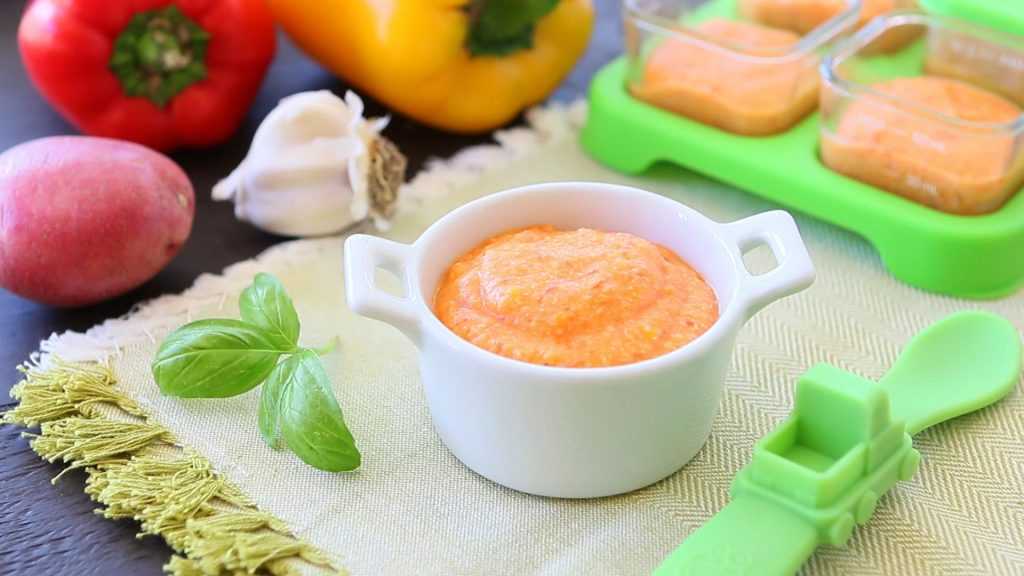
Do Commercial Baby Foods Have Lower Nitrate Levels?
Due to screening, commercial baby foods may contain a lower level of nitrates than homemade as parents do not have the ability to screen veggies for nitrates. Again, nitrates are naturally occurring in the vegetable itself and even the folks at Gerber/Beechnut/Heinz et al. cannot remove nitrates.
What are Nitrates and What is Blue Baby Syndrome?
When we first hear of nitrates and carrots, “Blue Baby Syndrome” and homemade baby food, it is often with a bit of fear and trepidation that we proceed to make baby’s food. We wish to do the best for our babies and we certainly do not want to poison them. Let’s take a moment to look at the facts about nitrates, infants and making baby food.
Nitrates are naturally occurring nitrogen/oxygen salt compounds found in almost every vegetable that we eat and the soils they are grown in. Nitrates are also laboratory formulated and used in fertilizers.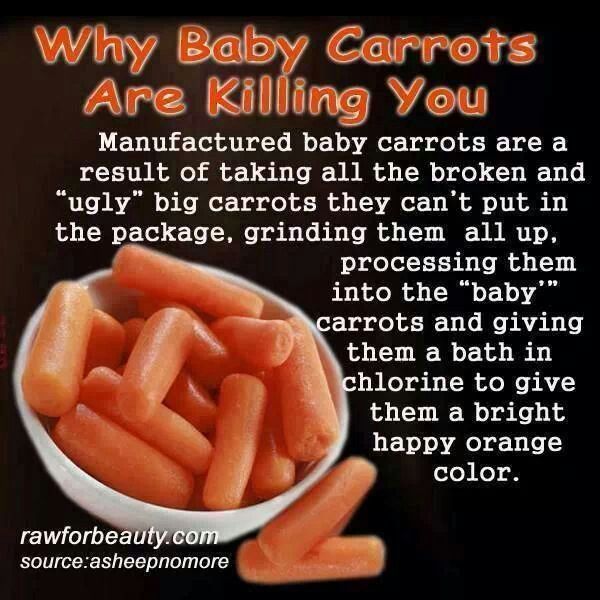 Nitrates are ingested either from vegetables or from drinking water. Nitrates/nitrites have been found to be responsible for “Blue Baby Syndrome.” Adults are not affected by nitrates or nitrites because their stomachs produce acids that fight the bacteria that help convert nitrates into nitrites. This conversion, and the resulting nitrite, is what allows for nitrate poisoning or “Blue Baby Syndrome.”
Nitrates are ingested either from vegetables or from drinking water. Nitrates/nitrites have been found to be responsible for “Blue Baby Syndrome.” Adults are not affected by nitrates or nitrites because their stomachs produce acids that fight the bacteria that help convert nitrates into nitrites. This conversion, and the resulting nitrite, is what allows for nitrate poisoning or “Blue Baby Syndrome.”
The name “Blue Baby Syndrome” stems from the fact that nitrites hinder proper oxygen transportation in the red blood cells. “Once in the blood, nitrite oxidizes iron in the hemoglobin of red blood cells to form methemoglobin, which lacks hemoglobin’s oxygen-carrying ability.”1 Without proper oxygen saturation in the blood, the body’s cells become oxygen deprived and the skin takes on a blue or purple hue. This oxygen deprivation may lead to the slow asphyxiation of the person poisoned.
Nitrate poisoning is very very rare and when it does occur, it is typically traced back to ground water contamination – specifically from contaminated private wells.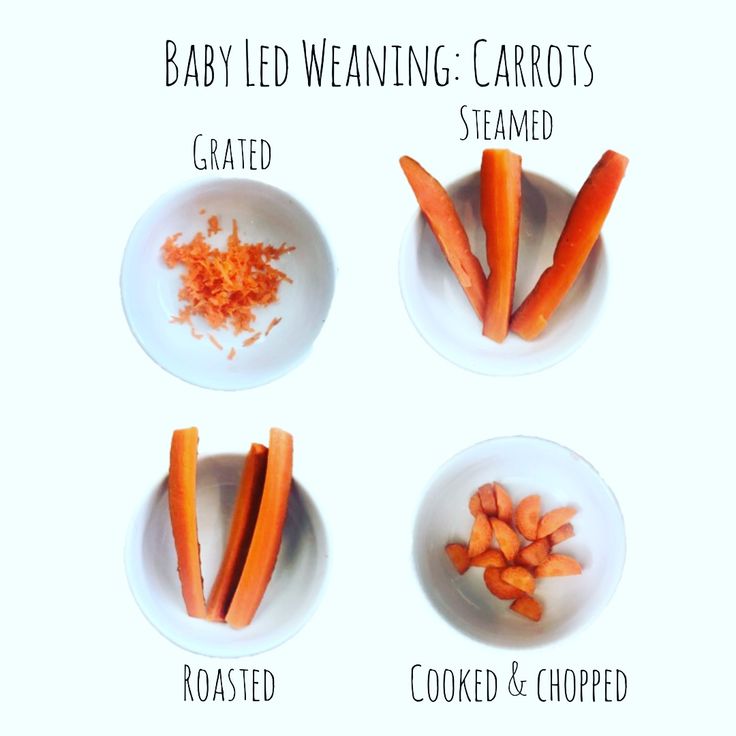 2
2
What are the Symptoms of Blue Baby Syndrome?
“The most obvious symptom of nitrate poisoning is a bluish color of the skin, particularly around the eyes and mouth. This is called cyanosis. A baby with these symptoms should be taken to an emergency medical facility immediately. The doctor will take a blood sample to be sure the baby is suffering from nitrate poisoning. The blood sample of an affected baby is a chocolate brown instead of a healthy red. Nitrate poisoning can be treated, and in most cases the baby makes a full recovery.
http://aces.nmsu.edu/pubs/_m/M-114.html“
What are the odds that my baby will get Blue Baby Syndrome?
It is important to note that the odds of your baby getting “Blue Baby Syndrome” nitrate poisoning from Carrots or other veggies is about 0%. By the time you introduce solid foods to your baby, his tummy should be developed enough to handle “normal” nitrate exposure.
“Around the age of three months, an increase in the amount of hydrochloric acid in a baby’s stomach kills most of the bacteria that convert nitrate to nitrite. By the time a baby is six months old, its digestive system is fully developed, and none of the nitrate-converting bacteria remain. In older children and adults, nitrate is absorbed and excreted, and Methemoglobinemia is no longer a concern.”
http://extension.missouri.edu
Yes, while nitrates are an important health concern, they are highly unlikely to poison your baby from the carrots that you make. Many pediatricians will tell you to not make homemade carrots while many other pediatricians will shrug off Nitrates and tell you there is no issue and no risk.
Does using Organic Vegetables eliminate or decrease nitrates?
If you prefer to make your own homemade baby foods vegetables that may contain nitrates, an alternative is to choose organic produce. Organic foods are grown without the use of commercial nitrate fertilizers and thus the risk of nitrate contamination/concentration is minimized, but not eliminated.
Freezing “nitrate veggies” does NOT increase nitrates
Studies done on spinach and nitrates in particular have shown that with improper storage and preparation, the nitrate levels may actually increase. Proper preparation and immediate use or storing via freezer method will help eliminate this risk (the increase in nitrate level) in leafy vegetables.
Will Boiling Vegetables Eliminate Nitrates?
Boiling vegetables in water will not eliminate nitrate concentration.
Nitrates may in fact seep into the water used for cooking. It is best to not use that water as the liquid to make your puree. Always use fresh water when pureeing vegetables that may contain nitrates and discard the cooking water.
Remember, always consult with your pediatrician regarding introducing solid foods to your baby and specifically discuss any foods that may pose allergy risks for your baby.
This site complies with the HONcode standard for trustworthy health information:
verify here.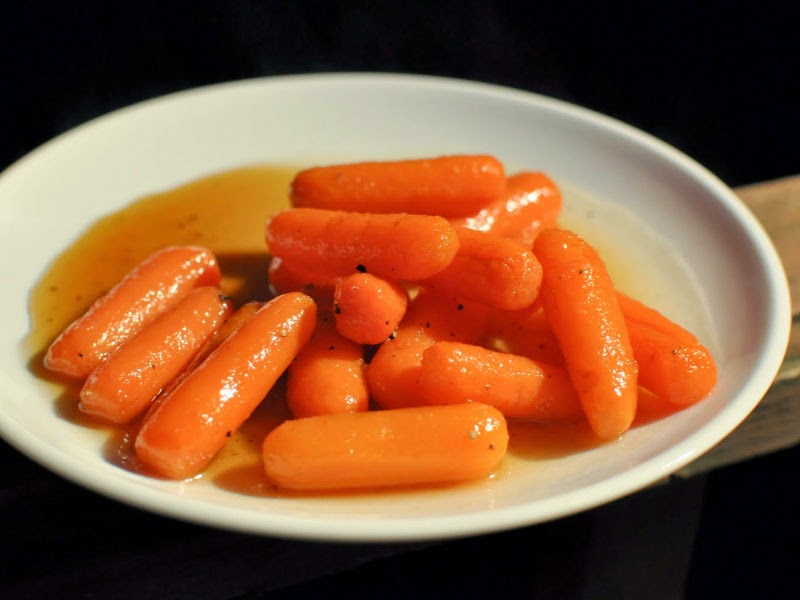
SHARE ON FACEBOOK SHARE ON PINTEREST
Root crops in child nutrition - NTsZD
Root crops proper include carrots, beets, rutabaga, turnips, radishes, radishes, parsley and celery. Potato and sweet potato (sweet potato) are tubers.
Root crops are a source of dietary fiber, sugars, vegetable protein, and the content of vitamins and minerals in them is higher than in the fruits and leaves of other plants. Radishes, radishes, turnips, parsley and celery roots have a high content of essential oils, which limits their use in the nutrition of young children.
Among the root crops, the most demanded carrot , which contains a lot of easily digestible carbohydrates, fiber and pectin, as well as essential oils, some essential amino acids and pigments necessary for the normal functioning of the organs of vision.. For baby food, carrots are useful primarily because of the high content in it of provitamin A, or carotene. This vitamin is also called the growth vitamin, and it is very important for babies, because it contributes to good vision, maintains the normal condition of the skin and mucous membranes. In addition to carotene, carrots contain B vitamins, vitamin C, K, PP, trace elements: iron, calcium, phosphorus, iodine. Carrots improve intestinal motility, the condition of the mucous membranes, accelerate the healing and regeneration of the skin. However, allergic reactions often occur on carrots, so it should be given to a child carefully, taking into account individual tolerance. It should be remembered that carotene belongs to the fat-soluble group of vitamins, therefore, for better absorption, it is good to add a little vegetable oil to carrots, and for older children - cream or sour cream.
This vitamin is also called the growth vitamin, and it is very important for babies, because it contributes to good vision, maintains the normal condition of the skin and mucous membranes. In addition to carotene, carrots contain B vitamins, vitamin C, K, PP, trace elements: iron, calcium, phosphorus, iodine. Carrots improve intestinal motility, the condition of the mucous membranes, accelerate the healing and regeneration of the skin. However, allergic reactions often occur on carrots, so it should be given to a child carefully, taking into account individual tolerance. It should be remembered that carotene belongs to the fat-soluble group of vitamins, therefore, for better absorption, it is good to add a little vegetable oil to carrots, and for older children - cream or sour cream.
It is better to “acquaint” a baby with carrots at the age of 6-7 months. When choosing carrots, pay attention to the appearance of the root. If the “head” of the root crop is green, it is better not to take it, because a dish made from such carrots will be tasteless. Most carotene is in the pulp closer to the edges, which is why it is colored brighter. But the pale yellow core should not be neglected either - it contains the pigment apigenin, which helps strengthen the heart muscle and relieve fatigue.
Most carotene is in the pulp closer to the edges, which is why it is colored brighter. But the pale yellow core should not be neglected either - it contains the pigment apigenin, which helps strengthen the heart muscle and relieve fatigue.
A useful vegetable for a child is beets . It is distinguished by a high content of easily digestible sugars (sucrose, fructose, glucose), fiber, organic acids, vitamins C, PP, group B, folic acid, carotenoids, bioflavonoids and mineral salts - potassium, sodium, magnesium, calcium, phosphorus and iron. The betaines present in beets (a group of phospholipids) contribute to better absorption of proteins, regulate fat metabolism, and improve liver and brain function. Mineral salts of calcium, phosphorus and iron regulate calcium-phosphorus metabolism and activate hematopoiesis. For medicinal purposes, beets are used to stimulate the activity of the intestines with a tendency to constipation. Beets can be safely added to the diet of babies older than a year.
Unlike other vegetables, beets retain vitamins and other useful substances all year round. However, it should be remembered that beetroot can cause allergic reactions, and if it is in excess, diarrhea may develop. In addition, beets actively absorb and accumulate nitrates from the soil. Therefore, for a child, you need to choose environmentally friendly beets and give them in moderation. For young children, the amount of beets is approximately 60 g or 12 teaspoons per day.
Turnip has long been valued in Rus' as a healthy and nutritious product. It contains indispensable elements that are necessary for human health. Turnip contains a large amount of vitamin C, which is stored in the root for a long time, contains vitamins B1, B2, PP, beta-carotene, E,. as well as iron, phosphorus, sodium, potassium, magnesium. Turnip is well boiled and absorbed in the gastrointestinal tract. However, the essential oils present in it do not allow the use of turnips in children of the first 2-3 years as the main product, but only in combination with other vegetables, as part of vegetable puree or in soups. Older children can consume the root crop both raw and after heat treatment.
Older children can consume the root crop both raw and after heat treatment.
Parsley root and celery root begin to be used only in the nutrition of children who have reached 2-3 years of age. In early childhood, it is recommended to use only the leaf part of plants as a source of vitamins (A, E, K, B6) and minerals (calcium, magnesium, potassium, iron), using them as seasonings for various dishes.
Celery root contains potassium, magnesium, iron and zinc. Parsley roots are rich in vitamins C, A, group B, minerals: potassium, calcium, magnesium, phosphorus, iron. Parsley leaves and roots supply rare elements to the human body: aluminum, lithium, vanadium, titanium, nickel, molybdenum, manganese.
Parsley and celery roots give dishes a distinctive flavor due to the presence of essential oils in them.
Rutabaga is a hybrid of turnip and cabbage, it is also called the Swedish turnip because it prefers the damp climate of temperate and northern latitudes. This root crop is rich in vitamins A, B, B6, P, minerals: calcium, magnesium, phosphorus, sodium, iron and sulfur. In addition, the swede contains sugar, protein, fiber and pectin. But most importantly, it is the undisputed leader among root crops in terms of vitamin C content. Due to its delicate structure, sweetish taste and rather high content of pectin, which promotes digestion, swede is an ideal food product. True, swede can cause excessive gas formation, so the baby should be given it carefully, starting from 8 months.
This root crop is rich in vitamins A, B, B6, P, minerals: calcium, magnesium, phosphorus, sodium, iron and sulfur. In addition, the swede contains sugar, protein, fiber and pectin. But most importantly, it is the undisputed leader among root crops in terms of vitamin C content. Due to its delicate structure, sweetish taste and rather high content of pectin, which promotes digestion, swede is an ideal food product. True, swede can cause excessive gas formation, so the baby should be given it carefully, starting from 8 months.
Rutabaga can be stored for several months without losing its useful properties; when cooked, it retains its valuable substances; it is better to cook it in a double boiler.
Widely used in baby food potatoes . It is high in starch, potassium and vitamin C, as well as vitamins P, B group and bio-flavonoids, which improve the absorption of vitamin C and strengthen the immune system.
Potato tubers are well boiled, the product is easily digested, but in some cases it can increase gas formation in the intestines. In the baby's menu, potatoes can be included from 5-6 months in the form of mashed potatoes.
In the baby's menu, potatoes can be included from 5-6 months in the form of mashed potatoes.
Carrots for children | Nutrilak
05/18/2022 Reading time: 6 min 5339
Contents of the article
- At what age can a child eat carrots
- Raw carrots for a child. What is useful in it
- Carrot juice for children
- Carrot salad for children
Can children have carrots? Perhaps one hundred percent of parents will answer this question in the affirmative, because everyone has heard about the beneficial properties of carrots. But from what age a child can receive carrots and how to introduce it into complementary foods - this is already a task with an asterisk. Cautious mothers will answer that a child can get carrots for the first time in a year, grandmothers will remember how they fed a baby with carrot juice at the age of three months. But what is it really?
Cautious mothers will answer that a child can get carrots for the first time in a year, grandmothers will remember how they fed a baby with carrot juice at the age of three months. But what is it really?
At what age can a child have carrots
Like any other brightly colored vegetable or fruit, carrots are potentially allergenic, that is, they cause unwanted reactions in the body more often than, for example, zucchini or cauliflower. For this reason, you should not introduce it into complementary foods as the first of the vegetables. Let the child's body gradually get used to the new food: first, it will learn to digest more neutral vegetables, and then, with some experience, it will get acquainted with the orange root crop.
Depending on the age at which the baby began to eat vegetables, carrots are introduced into his diet at about 6-7 months. Up to a year, it should be given boiled in the form of mashed potatoes.
It is not necessary to offer carrots as an independent dish. You can gradually, about a teaspoonful, add mashed boiled carrots or mashed carrots for a child to vegetables already introduced into complementary foods: zucchini, broccoli, cauliflower, potatoes.
You can gradually, about a teaspoonful, add mashed boiled carrots or mashed carrots for a child to vegetables already introduced into complementary foods: zucchini, broccoli, cauliflower, potatoes.
Raw carrots for a child. What is useful in it
Even children know that carrots need to be eaten for sharp vision, but they have much more useful properties. Vitamin A is indeed useful for vision. One of the sources of its receipt is beta-carotene, which is just rich in carrots. Vitamin A is also called the "vitamin of growth", and for good reason. It is responsible for the condition of the skin, bones, teeth, mucous membranes.
For strong immunity, proper metabolism in the body, other useful substances that are in carrots are also needed: calcium, potassium, sodium, phosphorus, B vitamins, vitamin C and E.
Dietary fibers of carrots: pectin, fiber - promote digestion, help fight constipation and bile stasis.
The maximum amount of useful substances is preserved in raw carrots, while most of them are destroyed during heat treatment.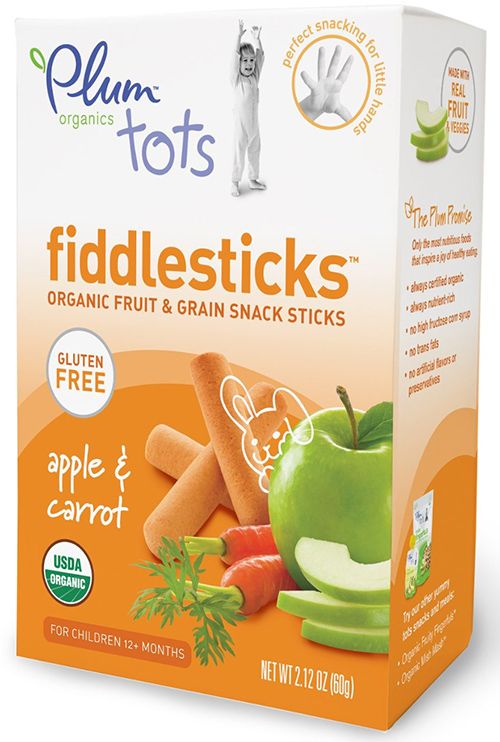 However, a child can try raw carrots not earlier than he is one year old. For an immature digestive system, it will be difficult to digest due to the coarse fibrous structure.
However, a child can try raw carrots not earlier than he is one year old. For an immature digestive system, it will be difficult to digest due to the coarse fibrous structure.
This is important!
Raw carrots for children are first grated and mixed with sour cream or vegetable oil, since vitamin A is fat-soluble, that is, it cannot be absorbed by the body without fat.
Chewing a whole carrot can be given to a child only when he learns to confidently chew solid food. If the baby bites off a piece, but cannot chew it properly, he may choke.
Carrot juice for children
Contrary to the experience and advice of grandmothers, who remember how they gave babies carrot juice at three to four months, you should not introduce it into the child’s diet until a year old, and then you should be more careful with this product.
Carrot juice is certainly rich in beta-carotene and other vitamins, but at the same time it can act aggressively on the organs of the digestive system.
This is important!
Up to two years, carrot juice should not be given to a child in its pure form, it should be diluted with water by about half. And even in a diluted form, it should not be on the menu every day: 1-2 times a week is enough.
Carrot salad for children
As part of salads, raw carrots can be given to a baby from the age of 1.5 years and older. Fill carrot salads with sour cream or vegetable oil. To diversify the taste and enhance the benefits, other components can be added to the carrot salad: vegetables, fruits and dried fruits.
For example, a baby might like a carrot, apple and raisin salad. Wash carrots and apples. Peel the carrots, remove the peel from the apple and remove the core. Grate the apple and carrot on a fine grater. Add pre-soaked in boiling water and well-washed raisins. Fill with sour cream.
A child over three years old can make a vitamin salad: grate carrots on a fine grater, finely chop cabbage, add finely chopped greens, season with vegetable oil.

 23 Infants fed commercially prepared infant foods after 3 months of age generally are not at risk of nitrate poisoning, although the containers should be refrigerated after first use and discarded within 24 hours of opening. ” AAP – Nitrate Statement
23 Infants fed commercially prepared infant foods after 3 months of age generally are not at risk of nitrate poisoning, although the containers should be refrigerated after first use and discarded within 24 hours of opening. ” AAP – Nitrate Statement 









